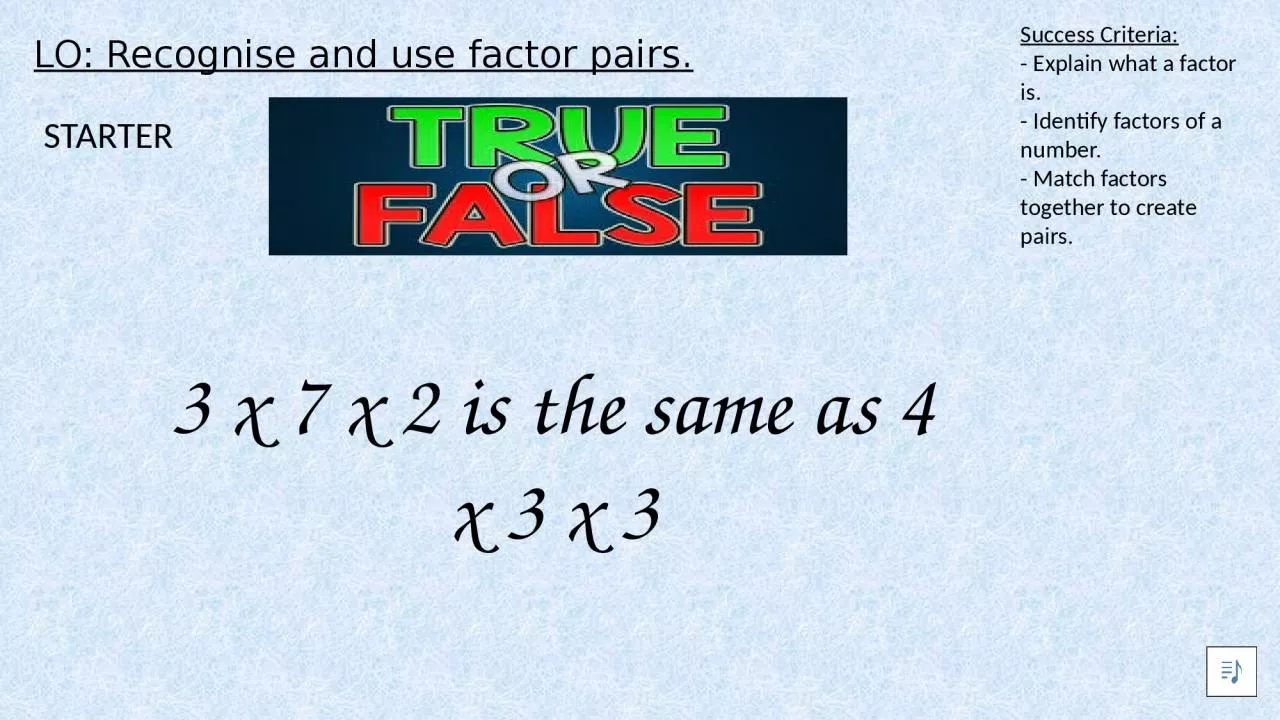

STARTER Success Criteria Explain what a factor is Identify factors of a number Match factors together to create pairs 3 x 7 x 2 is the same as 4 x 3 x 3 Activity 1 We can use arrays to find factor pairs ID: 1047498
Download Presentation The PPT/PDF document "LO: Recognise and use factor pairs." is the property of its rightful owner. Permission is granted to download and print the materials on this web site for personal, non-commercial use only, and to display it on your personal computer provided you do not modify the materials and that you retain all copyright notices contained in the materials. By downloading content from our website, you accept the terms of this agreement.
1. LO: Recognise and use factor pairs.STARTERSuccess Criteria:- Explain what a factor is.- Identify factors of a number.- Match factors together to create pairs. 3 x 7 x 2 is the same as 4 x 3 x 3
2. Activity 1We can use arrays to find factor pairs.If you have 16 of one object at home you can use them to help you (such as coins or pieces of lego).How many different arrays can you make using 16?Remember, each column and row in your array must contain the same number.LO: Recognise and use factor pairs.Success Criteria:- Explain what a factor is.- Identify factors of a number.- Match factors together to create pairs.
3. 1 x 16 = 162 x 8 = 164 x 4 = 16For the number 16 you can have 3 arrays.LO: Recognise and use factor pairs.Success Criteria:- Explain what a factor is.- Identify factors of a number.- Match factors together to create pairs.
4. What are factor pairs?These arrays have shown us the different pairs of numbers that multiply together to make 16.Pairs of numbers that multiply to make a particular number are called factor pairs!2 x 8 = 161 x 16 = 164 x 4 = 1616LO: Recognise and use factor pairs.Success Criteria:- Explain what a factor is.- Identify factors of a number.- Match factors together to create pairs.
5. Activity 2Lets see how many factor pairs we can think of for the number 28LO: Recognise and use factor pairs.Success Criteria:- Explain what a factor is.- Identify factors of a number.- Match factors together to create pairs.
6. For the number 28, there are 3 factor pairs.2 x 14 = 281 x 28 = 284 x 7 = 2828LO: Recognise and use factor pairs.Success Criteria:- Explain what a factor is.- Identify factors of a number.- Match factors together to create pairs.
7. LO: Recognise and use factor pairs.Success Criteria:- Explain what a factor is.- Identify factors of a number.- Match factors together to create pairs. Here are some questions for you to answer based on what you have learnt.1. Create as many arrays as you can for:820222. Copy the calculation and label with the 3 mathematical words (Factor, product, factor pair):2 x 3 = 63. True or false?1 is a factor of every product. Explain your answer.
8. 4. True or false?A factor is the amount that is created when products are multiplied together.Explain your answer. 5. True or false?8 has six factors. Explain your answer6. Write all of the numbers that are not factors of 64 1 2 3 4 5 6 7 8 9 107. Extension:LO: Recognise and use factor pairs.Success Criteria:- Explain what a factor is.- Identify factors of a number.- Match factors together to create pairs.